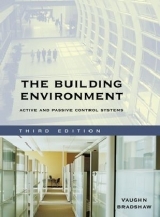
Building Control Systems
Seiten
1993
|
2nd Revised edition
John Wiley & Sons Inc (Verlag)
978-0-471-57378-4 (ISBN)
John Wiley & Sons Inc (Verlag)
978-0-471-57378-4 (ISBN)
- Titel ist leider vergriffen;
keine Neuauflage - Artikel merken
Zu diesem Artikel existiert eine Nachauflage
This volume provides a non-technical treatment of the physical principles and equipment related to building control systems, covering the pertinent aspects of HVAC, electrical, lighting, plumbing and acoustical systems.
Architects were once charged with designing entire buildings, including the HVAC, lighting and power systems. But with the advent of more complex technologies, engineers and other specialists became responsible for these systems, with architects assuming expanded roles as team managers. The latest edition of Building Control Systems provides architecture students with the larger picture without overwhelming them with details. In emphasizing a conceptual understanding of the functions of various systems and how they interact with building components, the book provides the exact information that tomorrows architects will need to effectively communicate and coordinate with consultants in all of the many building disciplines. This revised Second Edition covers the theoretical bases for thermal controlthe systems used to control the thermal environment within buildingsvarious electrical systems, including power and lightingsuch building control topics as plumbing services and fire protectionand economics-based design decision making.
Building Control Systems, Second Edition provides coverage of:New building designs that minimize our dependence on nonrenewable fuels and use only a "fair share" of renewable fuels with important steps toward cutting costs and preserving precious resourcesSuch pressing environmental concerns as indoor air quality, "sick building syndrome," noise pollution, global warming, and depletion of the ozone layer and the impact on building designNew technologies, including new passive thermal control systems designed to minimize energy consumptionThe latest building codes for architects and specialists on the design teamThoroughly up to date, this book provides architecture students with theoretical information they must have as they assume the dual roles of designer and manager. This guide will also prove to be a useful on-the-job tool for architects, designers, builders, developers, contractors, beginning HVAC designers, and building managers.
Architects were once charged with designing entire buildings, including the HVAC, lighting and power systems. But with the advent of more complex technologies, engineers and other specialists became responsible for these systems, with architects assuming expanded roles as team managers. The latest edition of Building Control Systems provides architecture students with the larger picture without overwhelming them with details. In emphasizing a conceptual understanding of the functions of various systems and how they interact with building components, the book provides the exact information that tomorrows architects will need to effectively communicate and coordinate with consultants in all of the many building disciplines. This revised Second Edition covers the theoretical bases for thermal controlthe systems used to control the thermal environment within buildingsvarious electrical systems, including power and lightingsuch building control topics as plumbing services and fire protectionand economics-based design decision making.
Building Control Systems, Second Edition provides coverage of:New building designs that minimize our dependence on nonrenewable fuels and use only a "fair share" of renewable fuels with important steps toward cutting costs and preserving precious resourcesSuch pressing environmental concerns as indoor air quality, "sick building syndrome," noise pollution, global warming, and depletion of the ozone layer and the impact on building designNew technologies, including new passive thermal control systems designed to minimize energy consumptionThe latest building codes for architects and specialists on the design teamThoroughly up to date, this book provides architecture students with theoretical information they must have as they assume the dual roles of designer and manager. This guide will also prove to be a useful on-the-job tool for architects, designers, builders, developers, contractors, beginning HVAC designers, and building managers.
VAUGHN BRADSHAW, PE, is a former Professor of Architecture in the School of Architecture at Washington University.
THERMAL CONTROL CONCEPTS. Human Comfort and Health Requirements. Thermodynamic Principles. Thermal Dynamics of Buildings. Load Calculations. THERMAL CONTROL SYSTEMS. Active HVAC Systems. Passive Methods. ELECTRICAL SYSTEMS. Lighting. Normal Electrical Service. On-Site Power Generation. Special Systems. ANCILLARY SERVICES. Plumbing Systems. Fire Protection. Architectural Acoustics. DESIGN ECONOMICS. Economics for Decision Making. Appendix. Indexes.
| Erscheint lt. Verlag | 26.10.1993 |
|---|---|
| Zusatzinfo | Illustrations |
| Verlagsort | New York |
| Sprache | englisch |
| Maße | 221 x 286 mm |
| Gewicht | 1644 g |
| Themenwelt | Technik ► Bauwesen |
| Technik ► Elektrotechnik / Energietechnik | |
| ISBN-10 | 0-471-57378-7 / 0471573787 |
| ISBN-13 | 978-0-471-57378-4 / 9780471573784 |
| Zustand | Neuware |
| Haben Sie eine Frage zum Produkt? |
Mehr entdecken
aus dem Bereich
aus dem Bereich
Grundlagen und Vorgehensweisen
Buch | Softcover (2021)
Springer Fachmedien Wiesbaden GmbH (Verlag)
CHF 53,15
Bemessung von Stahlbauten nach Eurocode mit zahlreichen Beispielen
Buch | Hardcover (2024)
Springer Vieweg (Verlag)
CHF 83,95
Kommentar zu VOB/C ATV DIN 18340, ATV DIN 18299
Buch | Softcover (2024)
DIN Media (Verlag)
CHF 96,55



